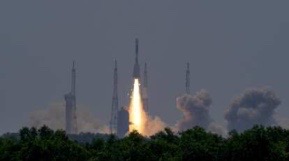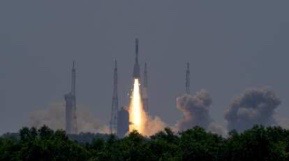The 2,232 kg satellite, which was deployed utilizing a Geosynchronous Satellite Launch Vehicle (GSLV) rocket, will contribute to India’s regional navigation system.

The navigation satellite NVS-01 was launched by ISRO’s GSLV rocket from the Satish Dhawan Space Centre located in Sriharikota. (PTI)
The Indian Space Research Organisation (ISRO) successfully launched the first of five second-generation satellites for the Navigation by Indian Constellation (NavIC). The satellite, weighing 2,232 kg, was launched using a Geosynchronous Satellite Launch Vehicle (GSLV) rocket. Its primary purpose is to enhance India’s regional navigation system by providing accurate and real-time navigation services.
The launch took place at 10:42 am from the second launch pad, and the satellite was inserted into a geosynchronous transfer orbit of 173 km * 40,700 km. Over the next few days, the satellite will be circularized to reach its final position. ISRO Chairperson S Somanath expressed confidence that the new satellites would make the NavIC system fully operational, despite previous issues such as failing atomic clocks and satellites reaching the end of their mission life.
Mission Director N P Giri highlighted the favourable orbit achieved during the launch, which is expected to extend the satellite’s operational life. The newly launched satellite has a mission life of over 12 years, surpassing the 10-year lifespan of the first-generation satellites in the NavIC constellation. The extended lifespan will allow for longer-term utilization of the satellite’s capabilities.
Notably, this launch marks the first use of the GSLV vehicle since its failure in August 2021. Following the failure, a failure analysis committee made recommendations for improvements, and necessary changes were implemented accordingly. The previous launch failed due to a malfunctioning valve, resulting in insufficient pressure in the liquid hydrogen tank of the cryogenic upper stage, which prevented ignition.
The successful launch of the second-generation satellite signifies an important milestone for ISRO’s NavIC system. With the constellation becoming fully functional and operational, there are significant opportunities ahead for the nation. The enhanced navigation capabilities offered by NavIC will benefit various sectors and contribute to India’s advancements in space technology.
Somanath expressed gratitude to the government for having faith in ISRO and granting authorization for the use of the GSLV vehicle despite its previous failure. He noted that the necessary corrections and modifications made to the cryogenic stage, along with the lessons learned from the failure, have significantly improved its reliability. This success not only applies to the recent launch but also to the LVM3 mission.
In addition to the successful launch, the GSLV vehicle utilized a new 4m Ogive payload fairing. This upgraded shield provides better protection for the housed satellites against atmospheric friction and heat. It also can accommodate larger payloads, expanding the possibilities for future missions.
The launch on Monday also marks a positive turnaround for ISRO, considering its reduced launch frequency during the past three pandemic years. In 2020, 2021, and 2022, there were only two launches each year. However, this launch in 2024 is already the third one. The previous launches this year have been noteworthy as well. The first one introduced the new Small Satellite Launch Vehicle to ISRO’s fleet, while the second launch established the reliability of the heaviest rocket, LVM Mk3, as a dependable commercial launcher. These achievements demonstrate ISRO’s continued progress and contributions to the space industry.
ISRO has experienced a year filled with significant activities, including the successful launch of various missions. Among these achievements are the launch of the first solar mission, the third lunar mission, and the upcoming test vehicle as part of the ambitious Gaganyaan mission, scheduled for later this year. These endeavours demonstrate ISRO’s dedication to exploring diverse aspects of space science and technology.
Furthermore, the ISRO chairman announced plans to utilize the same vehicle for upcoming missions. Following the recent launch, the vehicle will be employed for the deployment of the weather and meteorological satellite, INSAT-3DS. Additionally, it will be utilized for the NASA-ISRO Synthetic Aperture Radar (NISAR) satellite, highlighting the collaboration between ISRO and NASA in advancing space research and technology. These future missions demonstrate ISRO’s commitment to leveraging its capabilities and resources for a wide range of applications in satellite-based services and scientific exploration.












